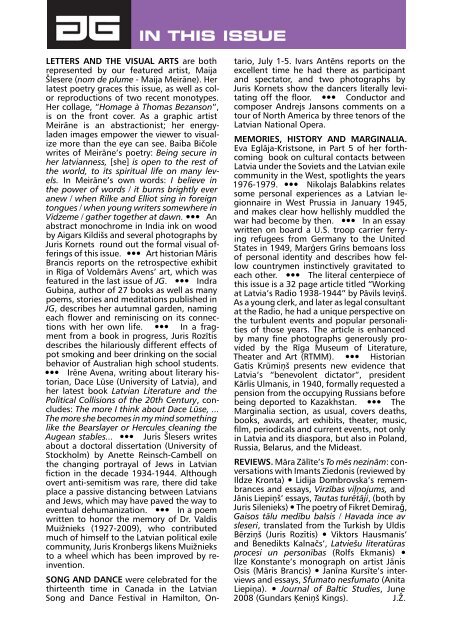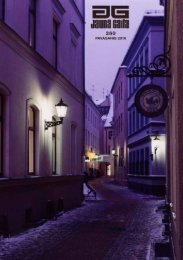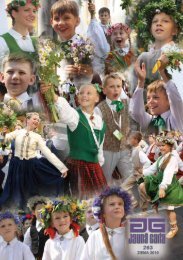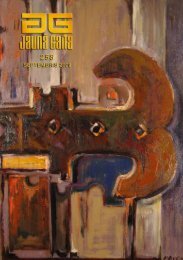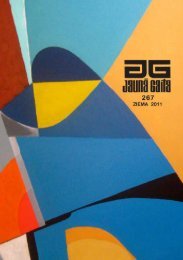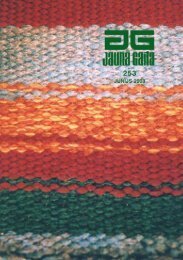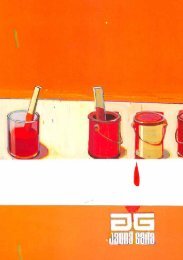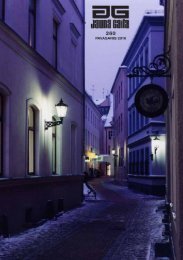Maketa fails - Jura ŽagariÅa mÄjas lapas
Maketa fails - Jura ŽagariÅa mÄjas lapas
Maketa fails - Jura ŽagariÅa mÄjas lapas
- No tags were found...
You also want an ePaper? Increase the reach of your titles
YUMPU automatically turns print PDFs into web optimized ePapers that Google loves.
LETTERS AND THE VISUAL ARTS are bothrepresented by our featured artist, MaijaŠlesere (nom de plume - Maija Meirāne). Herlatest poetry graces this issue, as well as colorreproductions of two recent monotypes.Her collage, “Homage à Thomas Bezanson”,is on the front cover. As a graphic artistMeirāne is an abstractionist; her energyladenimages empower the viewer to visualizemore than the eye can see. Baiba Bičolewrites of Meirāne’s poetry: Being secure inher latvianness, [she] is open to the rest ofthe world, to its spiritual life on many levels.In Meirāne’s own words: I believe inthe power of words / it burns brightly everanew / when Rilke and Elliot sing in foreigntongues / when young writers somewhere inVidzeme / gather together at dawn. ••• Anabstract monochrome in India ink on woodby Aigars Kildišs and several photographs byJuris Kornets round out the formal visual offeringsof this issue. ••• Art historian MārisBrancis reports on the retrospective exhibitin Rīga of Voldemārs Avens’ art, which wasfeatured in the last issue of JG. ••• IndraGubiņa, author of 27 books as well as manypoems, stories and meditations published inJG, describes her autumnal garden, namingeach flower and reminiscing on its connectionswith her own life. ••• In a fragmentfrom a book in progress, Juris Rozītisdescribes the hilariously different effects ofpot smoking and beer drinking on the socialbehavior of Australian high school students.••• Irēne Avena, writing about literary historian,Dace Lūse (University of Latvia), andher latest book Latvian Literature and thePolitical Collisions of the 20th Century, concludes:The more I think about Dace Lūse, ...The more she becomes in my mind somethinglike the Bearslayer or Hercules cleaning theAugean stables... ••• Juris Šlesers writesabout a doctoral dissertation (University ofStockholm) by Anette Reinsch-Cambell onthe changing portrayal of Jews in Latvianfiction in the decade 1934-1944. Althoughovert anti-semitism was rare, there did takeplace a passive distancing between Latviansand Jews, which may have paved the way toeventual dehumanization. ••• In a poemwritten to honor the memory of Dr. ValdisMuižnieks (1927-2009), who contributedmuch of himself to the Latvian political exilecommunity, Juris Kronbergs likens Muižnieksto a wheel which has been improved by reinvention.SONG AND DANCE were celebrated for thethirteenth time in Canada in the LatvianSong and Dance Festival in Hamilton, Ontario,July 1-5. Ivars Antēns reports on theexcellent time he had there as participantand spectator, and two photographs byJuris Kornets show the dancers literally levitatingoff the floor. ••• Conductor andcomposer Andrejs Jansons comments on atour of North America by three tenors of theLatvian National Opera.MEMORIES, HISTORY AND MARGINALIA.Eva Eglāja-Kristsone, in Part 5 of her forthcomingbook on cultural contacts betweenLatvia under the Soviets and the Latvian exilecommunity in the West, spotlights the years1976-1979. ••• Nikolajs Balabkins relatessome personal experiences as a Latvian legionnairein West Prussia in January 1945,and makes clear how hellishly muddled thewar had become by then. ••• In an essaywritten on board a U.S. troop carrier ferryingrefugees from Germany to the UnitedStates in 1949, Marģers Grīns bemoans lossof personal identity and describes how fellowcountrymen instinctively gravitated toeach other. ••• The literal centerpiece ofthis issue is a 32 page article titled “Workingat Latvia’s Radio 1938-1944” by Pāvils Ieviņš.As a young clerk, and later as legal consultantat the Radio, he had a unique perspective onthe turbulent events and popular personalitiesof those years. The article is enhancedby many fine photographs generously providedby the Rīga Museum of Literature,Theater and Art (RTMM). ••• HistorianGatis Krūmiņš presents new evidence thatLatvia’s “benevolent dictator”, presidentKārlis Ulmanis, in 1940, formally requested apension from the occupying Russians beforebeing deported to Kazakhstan. ••• TheMarginalia section, as usual, covers deaths,books, awards, art exhibits, theater, music,film, periodicals and current events, not onlyin Latvia and its diaspora, but also in Poland,Russia, Belarus, and the Mideast.REVIEWS. Māra Zālīte’s To mēs nezinām: conversationswith Imants Ziedonis (reviewed byIldze Kronta) • Lidija Dombrovska’s remembrancesand essays, Virzības viļņojums, andJānis Liepiņš’ essays, Tautas turētāji, (both byJuris Silenieks) • The poetry of Fikret Demirağ,Gaisos tālu medību balsis / Havada ince avsleseri, translated from the Turkish by UldisBērziņš (Juris Rozītis) • Viktors Hausmanis’and Benedikts Kalnačs’, Latviešu literatūrasprocesi un personības (Rolfs Ekmanis) •Ilze Konstante’s monograph on artist JānisOsis (Māris Brancis) • Janīna Kursīte’s interviewsand essays, Sfumato nesfumato (AnitaLiepiņa). • Journal of Baltic Studies, June2008 (Gundars Ķeniņš Kings). J.Ž.


